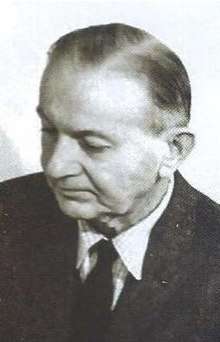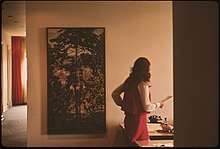Alexander Girard
Alexander Girard (May 24, 1907 – December 31, 1993), affectionately known as Sandro, was an architect, interior designer, furniture designer, industrial designer, and a textile designer.[2]
Alexander Hayden Girard | |
|---|---|
 | |
| Born | May 24, 1907 |
| Died | December 31, 1993 (aged 86) |
| Nationality | American |
| Alma mater | Royal Institute of British Architects, Royal School of Architecture in Rome |
| Known for | Architecture, textile design, interior design |
| Spouse(s) | Susan Needham Girard née March (m. 1936)[1] |
Early life
He was born in New York City to an American mother from Boston and a French-Italian father. He was raised in Florence, Italy and in 1917 he was sent as a boarder to Bedford Modern School in England leaving in 1924 to study architecture in London.[3][4][5] After also graduating from the Royal School of Architecture in Rome, Girard refined his skills in both Florence and New York.
Career
Girard is widely known for his contributions in the field of American textile design, particularly through his work for Herman Miller (1952 to 1973), where he created fabrics for the designs of George Nelson and Charles and Ray Eames.[6]
His work also includes designing the La Fonda del Sol Restaurant in New York (1960), the Herman Miller Showplace: T&O (Textiles and Objects) (1961), Braniff International Airways (1965), and the Girard Foundation (1962), which houses his extensive folk art collection. He and his wife, Susan Girard, amassed a remarkable collection of artifacts consisting of folk art, popular art, toys, and textiles from around the world, which is displayed through the Girard Foundation, founded 1962. One of the artists Girard supported was Cochiti Pueblo potter Helen Cordero, the creator of Storyteller pottery figurines.[7]
Girard at Herman Miller
Herman Miller Textiles Division
In 1952, Alexander Girard was hired to head the fabric and textile division.[8] Girard worked with George Nelson and Charles and Ray Eames to form a design team that has influenced the fundamentals of design throughout the United States and the rest of the world. Girard initially established a fabric collection based on his architectural training.[8] His first fabric line consisted of plain upholsteries and geometric drapery prints—stripes, circles, and triangles.[8] He went on to create many more patterns and designs, largely inspired by folk art.[8] He also worked with a 19th-century textile mill he discovered in central Mexico, to create a line of handwoven 100% cotton fabrics.[8] Because of the excellent quality and array of colors available, he developed a range of colorful "mexidots"and "mexistripes" which he used in many of his projects including installation backing, ground for environmental enrichment panels and upholstery.[8]
Girard also developed a furniture collection for Herman Miller in 1967 building on his designs for Braniff Airlines' lounge and office furniture which featured a low sight line and interior/exterior shell separate from the seat cushion to maximize varied upholstery.[8] Originals from this collection are rare and have become highly collectible, since they were quite expensive at the time and were in production only for one year.[8] In 1971, he developed 40 screen printed graphics on fabrics for Robert Propst's Action Office 2 System.[8] These Environmental Enrichment panels add a touch of warmth, color, and design to the office environment.[8]
T&O (Textiles and Objects) 1961
This Herman Miller showplace was a unique space filled with textiles and folk art pieces on Manhattan's East 53rd Street.[8] Textiles and Objects was an innovation demonstrating textiles as an integral part of interior displays for both designers and the individual consumer.[8] The showroom also featured folk art Girard collected from around the world.[8] T&O closed in shortly after opening, due to insufficient marketing and a public was not quite ready to add such colorful and exotic objects to the typical 1950s palette of their homes.[8]
Independent projects
Braniff Airways and "The End of The Plain Plane"
In May 1965, Girard began his design work for Braniff International Airways re-branding campaign called "The End of the Plain Plane". This project gave Girard the opportunity to work with textiles, color, and graphics on a grand scale, redesigning everything from the sugar packets to the ticket counters to the color of the planes themselves. He used colors like light and dark blue, beige, ochre, orange, turquoise, and lemon yellow to make the planes recognizable from the ground. Italian couturier fashion designer Emilio Pucci designed attendant uniforms.[9]
Girard also designed a line of furniture for Braniff's ticket offices and customer lounges. This furniture was also available to the public by Herman Miller in 1967 but was available for one year only.
Restaurants
In 1960, Girard designed every aspect of the La Fonda del Sol restaurant located in Manhattan's Time-Life building in a Latin American and contemporary theme/style, including menus, matchbooks, tableware and the ceramic tiles on the floors and walls. Girard created over eighty different sun motifs found throughout the restaurant.
As part of the commission, Charles and Ray Eames were brought in to design a fabric covered fiberglass chair and table, both with a new pedestal design. The chairs were similar to the plastic Eames chairs with a modification to the top silhouette of the fiberglass bucket.
Girard was also commissioned by Brody to design the L'Etoile Restaurant (1966) in the Sherry Netherlands Hotel, New York, a French restaurant with austere decor featuring a range of silver and greys featuring glass engraved with the names of French luminaries and daisy shaped tables in the bar.[10] The Compound Restaurant (1967), in Santa Fe, New Mexico, is in a clean modern yet traditional New Mexican style with inlaid Mexicotton ceiling tiles and nichos featuring a mix of folk art and Girard's own designs.
Georg Jensen
In 1956, Just Lunning, president of Georg Jensen, commissioned Girard to design seven table settings for an exhibition on 5th Avenue in New York. Each setting was created around a vignette outlining the personalities and situations of the company at the particular table. He created place mats and dishes specific to the project.
John Deere
Girard was commissioned to create a mural for the John Deere Company, in the entrance to their administration building designed by Eero Saarinen near Moline, Illinois. The mural is one hundred eighty feet long and eight feet high, created entirely with three dimensional found objects.
The Girard Foundation
In 1962, Girard and his wife established the Girard Foundation in Santa Fe to manage their art collection that numbered over 100,000 pieces, including toys, dolls, icons, and other ethnic expressions. Girard's design work was heavily influenced by his passion for folk art. In 1978, Girard contributed his immense collection to the Museum of International Folk Art in Santa Fe, New Mexico, United States. The museum opened to the public in 1953 and has gained national and international recognition as home to the world's largest collection of folk art.
The Girard Wing houses the popular permanent exhibition, Multiple Visions: A Common Bond, which showcases folk art, popular art, toys and textiles from more than 100 nations. Opening in 1982, this unorthodox and delightful exhibition was designed and installed by Girard, and remains popular with the public.
Additional projects

- Radio cabinets, interiors for Detrola Corporation (1943)
- Exhibition design, "Design for Modern Use, Made in U.S.A." Museum of Modern Art (1950)
- Rieveschi residence, Grosse Pointe, Michigan (1951)
- Miller House, Columbus, Indiana (1953)
- Exhibition design, "Good Design" Home Furnishings Exhibition, Museum of Modern Art (1954)
- Exhibition design, "Textiles and Ornamental Arts of India" Museum of Modern Art (1954)
- "Day of the Dead" documentary film, collaboration with Charles Eames (1956)
- Nativity Exhibition, sponsored by Hallmark Cards, Atkins Museum, Kansas City, Missouri
- Penthouse apartment for Hallmark Cards, Hallmark Building, Kansas City (1962)
- Gregory residence, Wayzata, Minnesota (1963)
- Interior design of the campus of St. John's College, Santa Fe, New Mexico (1964)
- Indian government commissioned Girard and Eames to design the Memorial Exhibition for Nehru, Delhi, India (1965)
- "El Encanto de un Pueblo (The Magic of a People): International Exhibit for Hemisfair, San Antonio, Texas (1968)
Exhibitions
- Cooper Hewitt, Smithsonian Design Museum, The Opulent Eye of Alexander Girard, 2001
- San Francisco Museum of Modern Art, Alexander Girard: Vibrant Modern, 2006
References
- Maxon, Aleishall Girard. "Maintaining Her Own Vision". WHY Magazine. Herman Miller, Inc. Retrieved February 12, 2019.
- "009 Girard obituary from Herman Miller Inc.'s Connections · BCPL Archives". bcplarchives.omeka.net. Retrieved June 29, 2019.
- Eagle News, The Magazine of the Old Bedford Modernians' Club, Issue 114, Winter 2016/17
- "Vitra Design Museum present Alexander Girard. A Designer's Universe – smow Blog English". March 12, 2016.
- "Eagle News 2016/17".
- "Alexander Hayden Girard". Collection of Cooper Hewitt, Smithsonian Design Museum. Retrieved February 12, 2019.
- "Helen Cordero, Cochiti Pueblo". Adobe Gallery, Santa Fe. Retrieved February 20, 2014.
- "Alexander Girard". www.hermanmiller.com. Retrieved June 29, 2019.
- Nance, John J. (1984). Splash of Colors The Self Destruction of Braniff International. New York: William and Morrow Company. pp. 33–35. ISBN 0-688-03586-8.
- Interiors Magazine, 1966
Further reading
- Pina, Leslie (1998). Alexander Girard Designs for Herman Miller. Schiffer Publishing Ltd.
- Forde, Laura (2003). Alexander Girard the Textures of Modernism and the Joys of Folk Art. Modern Crafts No. 7. Petit Grand Publishing, Inc.
- Grawe, Sam (February 2008). "Alexander the Great". Dwell.
- Glassie, Henry. The Spirit of Folk Art: The Girard Collection at the Museum of International Folk Art. Archived from the original on May 28, 2007. – A 276-page set of essays which describe the content and importance of the Girard collection. The essays are complemented by black and white as well as color plates of collection objects on display at the Museum.
- Larsen, Jack Lenor. Folk Art from the Global Village: The Girard Collection at the Museum of International Folk Art. – A 96-page set of essays which describe the Girard collection and its origins. The book, which contains over 100 color plates of objects described in the essays, is currently out of print.
External links
- Braniff Flying Colors Historical Page
- Girard Wing
- Girard at Braniff
- Dwell Magazine Article
- House Industries Girard Collection produced in conjunction with the Girard estate and Máximo House Industries
- Alexandar Girard's works in Columbus, Indiana
.jpg)
